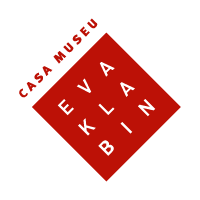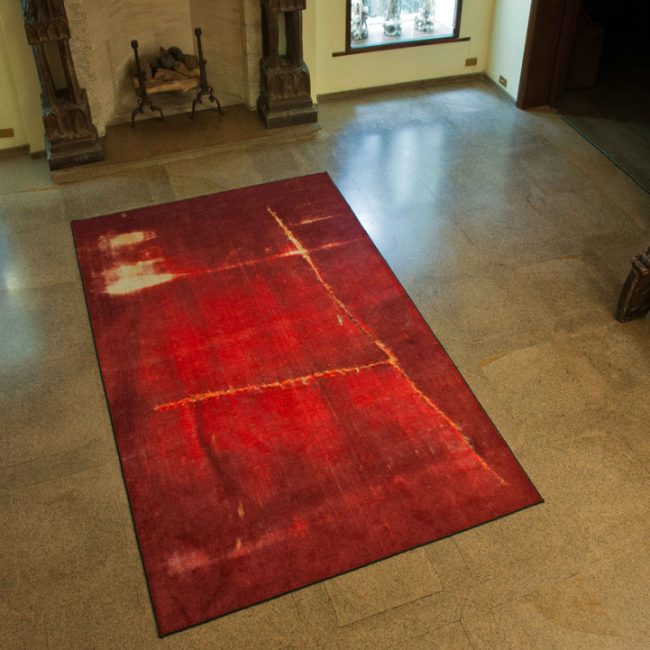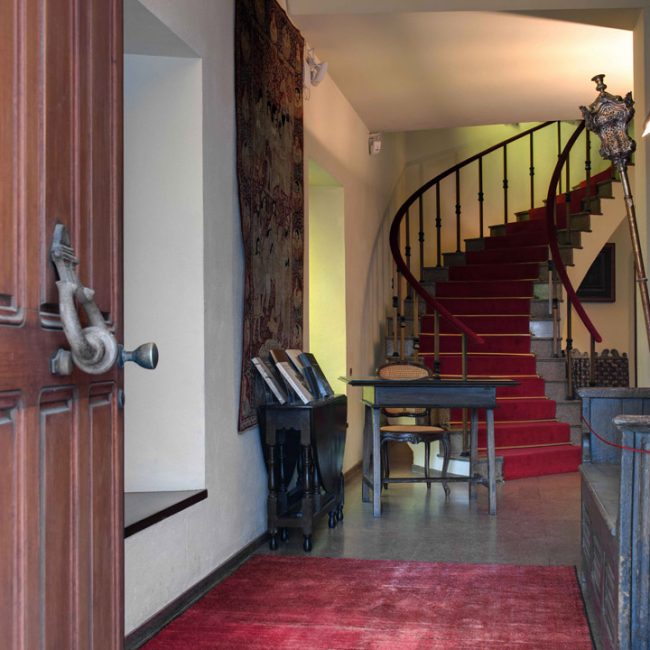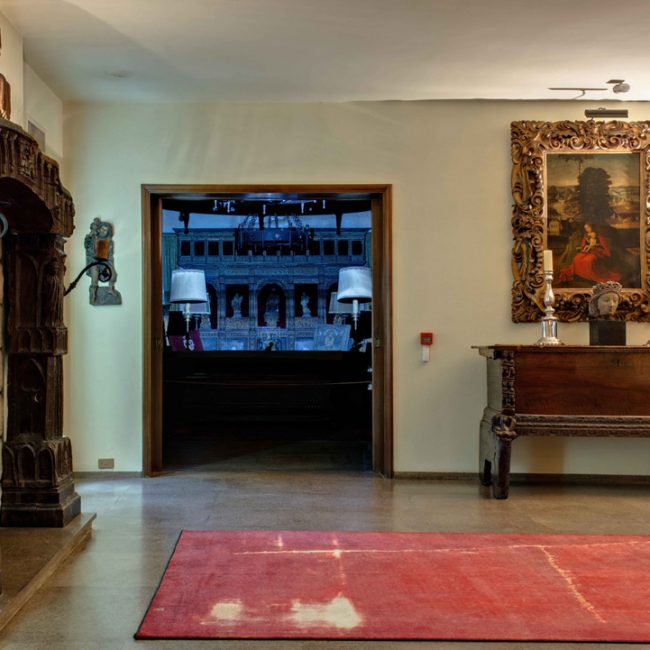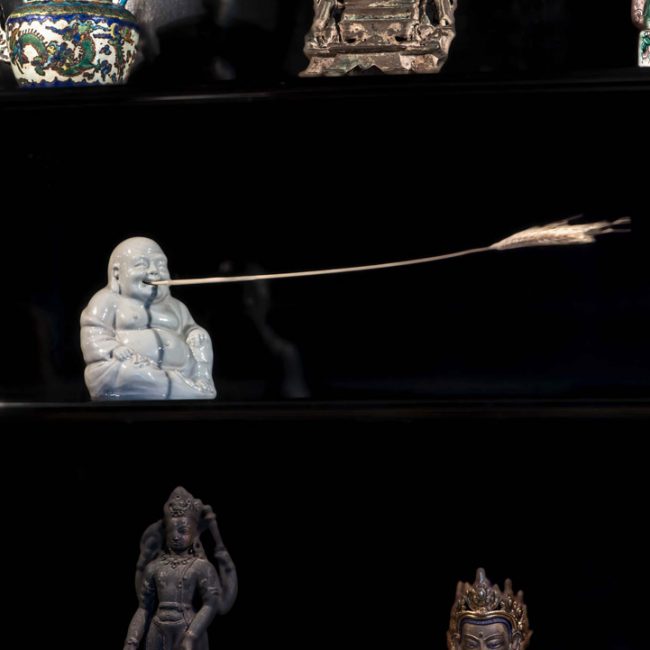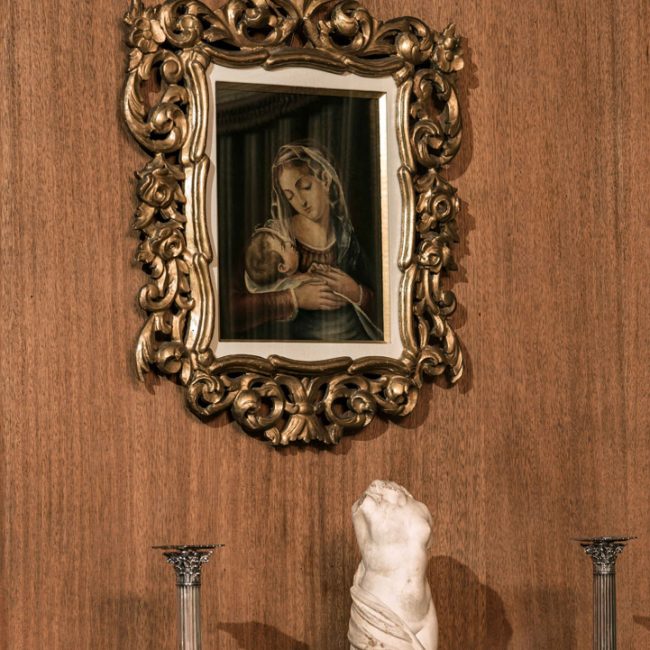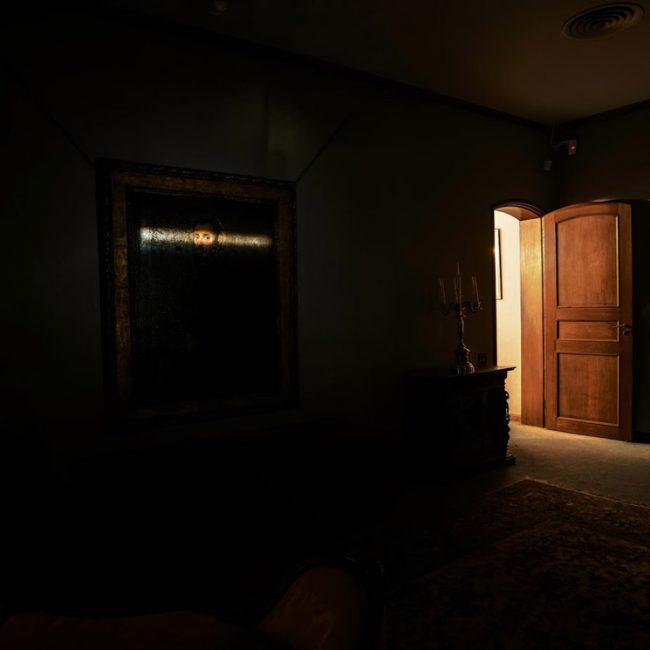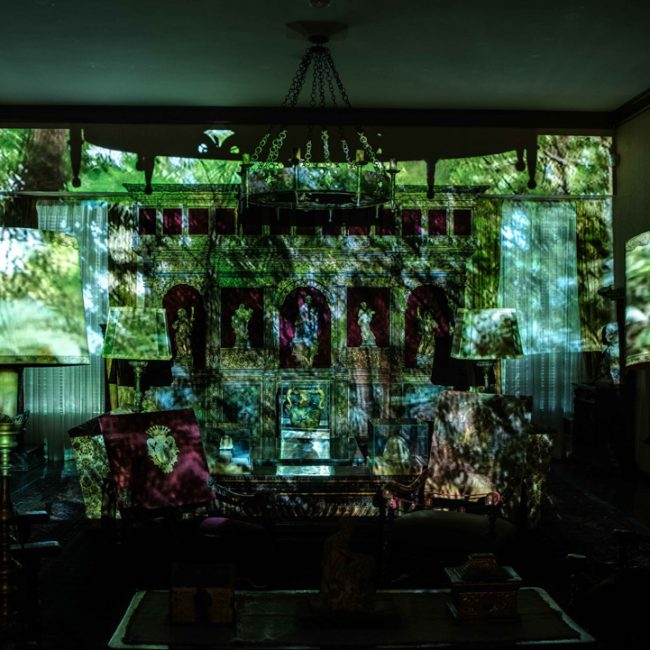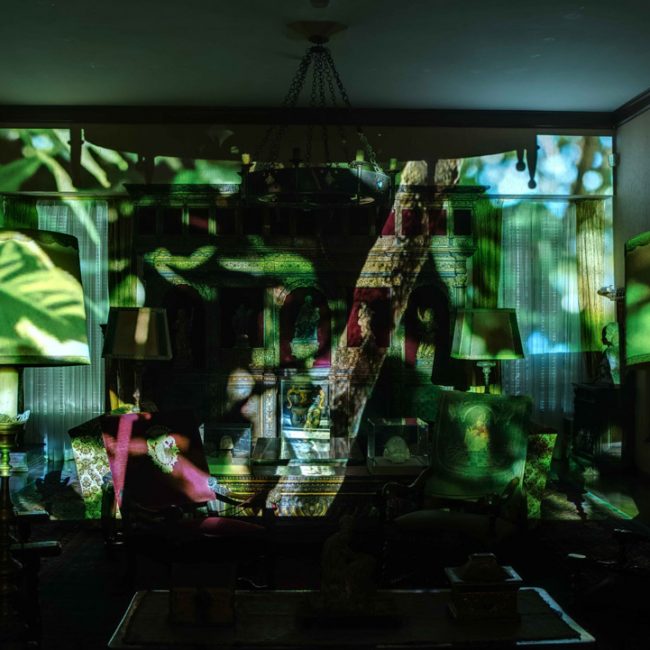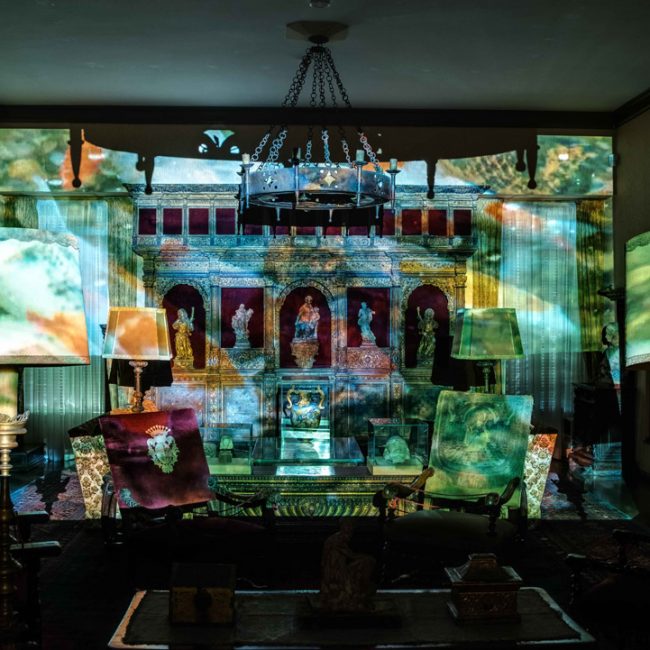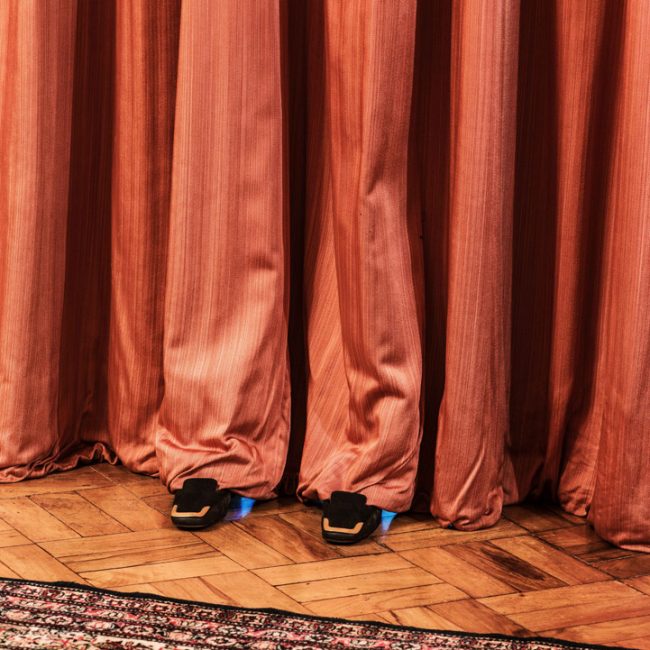Marcos
Chaves
I ONLY HAVE EYES FOR YOU
17th edition | september 03 – november 10 2013
DUCHAVIAN MANOEUVRE
Without fear of words, yet carefully picking each new one as a new thought, I am struck by how powerful they are and how surely they meet their mark. It is with this spirit that I have investigated the acts, actions and facts created by Marcos Chaves in the Eva Klabin house museum, in his delicate incursion into the house and collection, which were not unfamiliar to him but which he wished to deliver of the sense of defamiliarization and discomfi ture that has struck so many for so long. Marcos Chaves approached this space as if he wanted to liberate it from the defamiliarization caused by the confi ned layers of time accumulated over the years, the hoarding of art objects from different periods, and the sheer length of time the owner has been away from this home, lending it a kind of absent presence that weighs on the imaginary of its visitors. Chaves first wanted to refresh the house museum in a kind of “spiritual cleansing”, which is not unlike one of the goals of the Breathing Project when it proposes to breathe new life into the house by presenting it with art from our time, renewing and giving it a fresh lease of life. Like a “shaman”, Marcos Chaves created particular codes of “spiritual cleansing” for the house so that he could take action freely to recover the same free spirit which probably inspired the idea of building and adapting this residence into a foundation. In other words, he wanted to release the house museum from the forces that bound it to its creator by making bold moves designed to divert time and deliver the house to those who wished to be there without being overwhelmed by Eva Klabin?s natural desire to remain. Arguably, only an artist like Marcos Chaves could divest this space of the elements that define it without distorting its essence, because through his innate light-heartedness he can fold the resistance of the situation itself.
It is the artist himself who gives an insight into this process in an interview with Gloria Ferreira and Lula Vanderley, saying: “In my case I use humour, détournement, folding, to give fresh perspectives on the same thing.”1 In this same interview he also declares his artistic debt to Marcel Duchamp, for his having introduced the strategy of détournement in art, removing objects from their original contexts and resignifying them by introducing them to the concept of art. Later in the same interview he talks of the influence on his work of his teacher, Lygia Pape. I agree with what Chaves says, but I would stress more of the humour, the folding, and Lygia Pape than the influence of Duchamp, which, present though it may be, I regard more as a construct of irreducibility from which there is no escape for the contemporary artist. That is why I would hazard to say that Marcos Chaves’s approach is not so much Duchampian as Duchavian: it has its own traits and owes more to Foucault?s concept of the fold (also a source of inspiration for Lygia Pape) than Duchamp’s manoeuvre. For me, the key is that Chaves’s work has more to do with how to look than with the eye’s view. But this is no different from what many have said before me and with more authority than myself. But what I do perceive is that more than looking, the eye’s view that takes shape has nothing of the sublime. It is straight to the point and does not waste time with banal embellishments. Domestic daily life is banal enough as it is… Yet daily life is actually not banal for Chaves: it is his raw material, the source from which he extracts the incongruity of difference; the paradox in the clarity of seeing what is there, then being made to see what we pretended not to, effected by his plays on words. Crystal-clear vision. In this respect, Lygia Pape’s presence can clearly be felt. Chaves addresses what is there and does not make any moral distinction between high and low culture, fine art or popular art. He strives to show that every element of reality is full of potential and can be transformed into art.
To paraphrase Enrica Bernardelli: art can help change our perception of daily life – whatever is ingrained by habit in a given reality. This Duchavian manoeuvre draws on humour and word games to subvert the place where things belong. Although we know the word cannot be reduced to the image nor the image to the word, Marcos Chaves folds word and image by attributing the indicative power of the word to the image and the indisputable presence of the image to the word. He folds the potency of one with the element of the other. This folding is where the Duchavian strategy (related to Foucault) takes place, because it yields a paradox, which is the place that illuminates and silences. It speaks with images. In Eva Klabin’s bedroom we find “I Only Have Eyes for You”, a title borrowed from the 1934 song by Al Dubin and Harry Warren, recorded by Art Garfunkel and also the title of the exhibition. In it, Marcos Chaves sets up a circle of views, starting with his own view of Eva Klabin and ending with the public seeing the house and the collection through his eyes.
In this work the eyes of Nicolaus Padavinus, painted by Tintoretto, are lit in such a way as to establish an intimate gaze between the man in the portrait (or Tintoretto) and the collector’s bed (or Eva Klabin). This tacit complicity alludes to the inherent sensuality of the bedchamber, while also suggesting a shared look or the unavoidable voyeurism in the act of visiting museums and exhibitions. And it also plays on the idea that we all have eyes for Eva Klabin when we visit her house and collection.
With the same theme of sensuality, “Hot Widow”, in the Upper Hall, is a parody on Marcel Duchamp’s “Fresh Widow”. Here, what we see is a projection of the window on the window itself. By folding the projection – which has a different register from folding the same thing over the same thing – the window ceases to be the same. Here, Marcos Chaves exercises one of the main manoeuvres of his work. To quote Luisa Duarte: “It’s the same, but then it isn’t the same because of a simple and slight shifting of the eye’s view.” 2 I would also add that the same also ceases to be the same because when the virtual and real images shift simultaneously and the verbal register is added, folds are created between these different elements, laying bare paradoxes and letting loose other layers of meaning, especially humour. Humour is Chaves’s mainstay. With humour, as the artist himself says, he strips things of the tragic, and I would add that in the specific case of the Eva Klabin Foundation, humour strips the house museum of its austerity, which is inconsistent with the personality of its founder. In “Cartoon Soundtrack” in the dining room, we are surprised by a noise of glass breaking and cutlery clinking. Is Eva Klabin playing a prank? Yes. There she is, hiding behind
the curtain, given away by the toes of her shoes, having fun as she watches the effect
of her joke on her visitors. Eva Klabin was fun-loving and irreverent and she left us a clue to this personality trait by placing Mestre’s “Madonna of the Unruly Child” in the middle of the altar that dominates the Renaissance Room. To quote Ligia Canongia’s fine text on Marcos Chaves entitled “Void and totality”, which alludes to Freud’s theory of jokes: “Humour intrudes on the original meaning of the object and spawns another [meaning] by making an unexpected move, upsetting the balance, almost a joke.”3
In the Renaissance Room we have “Cleansed Cinema”, where the Mannerist altar at the
back of the room and indeed the whole room itself is turned into a canvas for images of the Rio de Janeiro natural landscape, apprehended by Marcos Chaves for its Baroque potential. The naturally twisted forest and choppy sea is presented as a backdrop for a “baroquized” expression of our visual culture. It is interesting to remember that the origin of this perception may well lie in the fact that Brazilian Modernism overlooks nineteenth century Neo-Classicism, creating a direct bridge between colonial baroque and Modern Art. But what interests us in “Cleansed Cinema” is the new fold the artist introduces between the baroque image he creates of the natural landscape and the images of colonial Brazilian baroque churches he projects onto the altar. Baroque twice over: the same thing on the same thing but without being the same: not for the purpose of emphasis, but to reveal new layers of interpretation. Alongside “Cleansed Cinema”, the “cleansed” images bring a play of words on the “spiritual cleansing” we referred to earlier (which does not have any strictly religious meaning). This was important for Marcos Chaves to produce the lighter atmosphere he needed and is even more evident in the images of the mass he put on in memory of his mother and Eva Klabin and also the images of a censer which moves about the house like a flying saucer enveloped in smoke, spreading incense through the different rooms, as if to continue the cleansing process as long as the intervention remains. “Cleansed Cinema” turns the Renaissance Room into a film installation and brings us back to an important reflection about the Breathing Project, which is the issue of the virtual and the real. The Eva Klabin house museum, like film and photography, is a past made present; it is both real virtuality and virtual reality. This is the recurring theme that is arguably the strongest and most significant aspect of the project. Indeed, it is precisely this idea that is stressed by Marcos Chaves at the very entrance to the house, in the Main Hall, where we find three rugs with reproductions of details from fabrics from the collection – fabrics Eva Klabin collected from the seventeenth, eighteenth and nineteenth centuries in what is surely the most private of her collecting activities. “Zoom” is what we fi rst encounter, reminding us that the Duchavian manoeuvre consists of enriching the obvious, stripping it of
the banality that shields it.
This straightforward way of addressing reality indicates a kind of transparency which demonstrates that the mystery of the world cannot be hidden, that metaphysics is immanent in reality, and that artists have the power to convey this. With his semantic games, Marcos Chaves extracts visibility from words and thus puts the image back into a new reality, showing that even what at fi rst sight seems obvious and banal has a wealth of potential that we might fail to notice.
MARCIO DOCTORS
Notes
1 ferreira, Glória and wanderley, Lula. Interview in ArteBra Marcos Chaves. Rio de Janeiro:
Casa da Palavra Produção Editorial, 2007. p. 129.
2 duarte, Luisa. O Desvio é o alvo in ArteBra Marcos Chaves. Rio de Janeiro: Casa da Palavra
Produção Editorial, 2007. p. 99.
3 canongia, Lygia. Vazio e totalidade in ArteBra Marcos Chaves. Rio de Janeiro: Casa da Palavra
Produção Editorial, 2007. p. 87
LIST OF WORKS
Main Hall – Zoom
Renaissance Room – Cleansed Cinema
English Room – Painting of the artist?s mother
Dining Room – Cartoon Soundtrack
Chinese Room – Spell
Upper Hall – Hot Widow
Bedroom – I only have eyes for you
trad. Rebecca Atkinson
